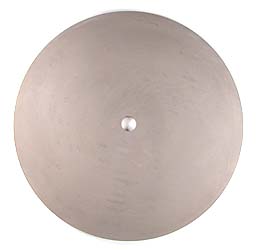What are Sintered Laps?
Sintered laps are expensive, metal/diamond bonded gem cutting laps. Are they worth the investment? Learn about their advantages and disadvantages.
2 Minute Read
Basically, sintered laps are a type of gem faceting lap with diamonds mixed solidly all the way through the lap. The diamond is bonded into the actual metal of the lap, not plated.
Are Sintered Laps Worth It?
Since these metal/diamond laps contain a significant amount of diamonds, they tend to be very expensive. However, if you can afford them or need them for your gem cutting business, they are well worth the money. Few people can probably justify buying them. So, their production numbers run low, too.
What are the Advantages of Sintered Laps?
These laps have three major advantages:
- They cut extremely well.
- Usually, they are quite aggressive, cutting fast and smooth.
- They maintain these qualities for a very long time.
Indeed, sintered laps are said to outlast standard bonded laps by quite a while. I've heard claims that they last longer than ten plated laps. While I wouldn't make that claim, and no real life statistics cover their wear, suffice to say a quality sintered lap will cut and wear a very long time.
What are the Disadvantages of Sintered Laps?
Cost likely ranks as the greatest disadvantage of these laps. Many dealers don't stock them, either.
In practical terms, how sintered laps wear may pose a problem. Remember, these laps are solid metal/diamond, not plated. So, as time goes by, if the cutter isn't careful and uses one or two particular areas on the laps, the laps will become grooved and not flat.
Although this type of wear on a sintered lap happens gradually over many years, a lack of flatness poses a major problem for the faceter. To avoid grooving a sintered lap, make sure to use the whole lap surface, carefully, of course. Don't cut in any one area of the lap excessively.
In general, on a coarse lap, a bit of wear and some non-flatness won't make a critical difference. On the other hand, on a fine lap, like a 1,200-grit, keeping it flat is very important.
My Personal Experiences
I really like the aggressiveness of sintered laps. However, in my experience, I can't go directly from a sintered lap to an oxide polish. (In contrast, I can do this when using a well-worn plated lap). So, from a sintered lap, I have to go to a 3K pre-polish. While this adds another step to my cutting, the sintered 1,200 is so aggressive I basically never use the 600 laps anymore. Since that eliminates a step, it's a wash timewise.
I must note that my sintered 1,200 has very, very slowly become a bit finer with continued use. Someday, it may become fine enough to go directly to polish from it. That's not happening anytime soon, however. So, if you go with a sintered 1,200, plan on adding a 3K pre-polish step for a while.
Note: Usually, some kind of pre-polish is needed, such as 8K on tin or some other combination like a 3K on phenolic.
Conclusion
Who should buy a sintered lap? Well, anyone that likes fine tools will appreciate one, but these laps are really for serious gem cutters. Unless you cut a lot of gems or cut for long periods of time, you don't need sintered laps.
Personally, I like them and use them, but they're not for everyone.
Jeff R. Graham
The late Jeff Graham was a prolific faceter, creator of many original faceting designs, and the author of several highly-regarded instructional faceting books such as Gram Faceting Designs.
Related Articles
Several Ways to Polish Sapphires
How to Score Polishing Laps
Odd Symmetry Designs for Gemstones
Having an Unaligned Machine
Latest Articles
Quartz Toxicity: Understanding the Risks for Jewelers and Wearers
Synthetic Amethyst: What is it and How is it Made?
Hambergite Value, Price, and Jewelry Information
Pearl Simulants: How to Spot Faux Pearls
Never Stop Learning
When you join the IGS community, you get trusted diamond & gemstone information when you need it.
Get Gemology Insights
Get started with the International Gem Society’s free guide to gemstone identification. Join our weekly newsletter & get a free copy of the Gem ID Checklist!
